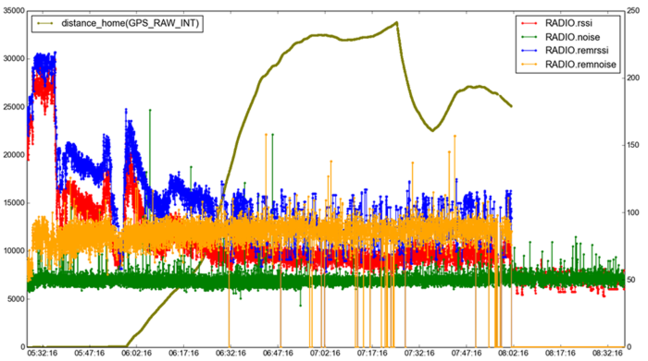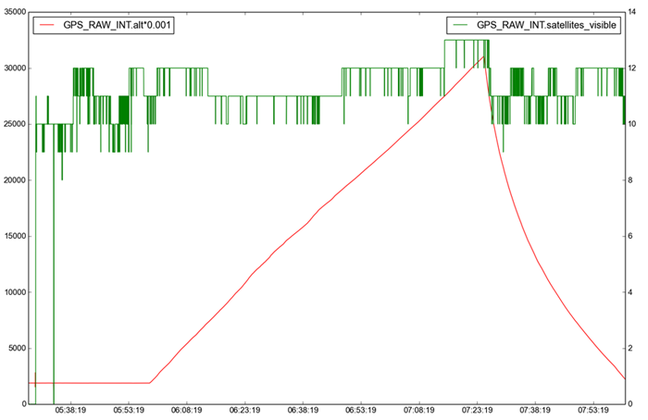This article is more than 1 year old
PRATCHETT chats to Oz from 31,000m above Planet Earth
Andrew Tridgell tunes into LOHAN avionics test flight
900Mhz radio rig
This being LOHAN, we couldn't have everything going exactly according to plan, and there were some issues with the radio. We'll let Tridge explain:
The radio setup was a RFD900 running at 27dBm on the ground station, with a 6dBi yagi. The payload in the balloon had a RFD900u running at 15dBm.
Note that the RFD900 is capable of transmitting at 30dBm (1W) but we reduced it to 27dBm on the day to prevent issues with drawing too much power from the laptops USB bus. The RFD900u is capable of transmitting at 20dBm but we reduced it to 15dBm as we had an issue in preflight checks with the power supply to the Pixhawk browning out the radio when the RFD900u was set to full power. Reducing by 5dB fixed that.
This graph shows the comms quality for the test flight:
The olive line is the distance from the payload to the ground station (including both horizontal and vertical components). So the payload got to a maximum of 34km away from the ground station. The line stops at the right side of the graph when the payload lands and we lose link completely, about 25km from the ground station.
The red and green lines are the signal strength and noise levels in RSSI units as seen at the ground station. A link can be maintained as long as the red line stays above the green line. It shows that a good link from the payload down to the GCS was maintained over the whole flight, with only a few very brief periods where the link dropped (you can see when the link dropped when the yellow line goes to zero).
The blue and yellow lines are the signal strength and noise levels as seen by the payload radio and recorded by the ground station. It shows that the payload got a stronger signal than the ground station did (as the ground station had a more powerful transmitter). What is more interesting is that the noise level in the payload was very high (the yellow line). It is very clear that the limiting factor in the communications system was RF noise level in the payload.
On the far left of the graph you can see where the noise level in the payload suddenly jumps shortly after the system is turned on. That is likely a sign that some other pieces of equipment in the payload was switched on at that point and was radiating a lot in the 900MHz band. To improve the communications link we need to identify what piece of equipment this was and reduce its level of interference.
If that noise hadn't been introduced then the blue line would have been above the yellow line the whole flight and we could have had continuous two-way link. As it was, we ended up with a one-way link for large portions of the flight, as RF noise in the payload blocked incoming signals from the GCS. So we knew exactly what the vehicle was doing, but we wouldn't have been able to change the settings in the Pixhawk reliably if we needed to.
Still, it was a good result and the RFD900 radios performed extremely well. Congratulations to Seppo from RFDesign.
Yes indeed. We're working on fixes for the laptop USB power draw issue, and attempting to identify what was causing the interference. When we've nailed it, we'll resolve the problem.
GPS
We had a few LOHAN fans expressing concerns that the radio might interfere with the Pixhawk's GPS unit. No so, according to the data logs which show a good fix with generally 11 or 12 satellites for the entire flight.
It's worth mentioning that the Vulture 2 has two vertically-opposed GPS units, just in case the aircraft finds itself on its back. Highly unlikely of course, but still...


